Celebrating Our Centennial: 100 Years of the Philadelphia PGA Section
As the Philadelphia PGA Section turns 100, we take a look back at the people and events that helped make the Section what it is today, with the help of Section Historian Pete Trenham, PGA, and his website Trenham Golf History.
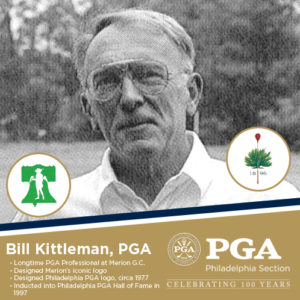
Bill Kittleman was born in Greenville, Mississippi in 1932. Some Greenville men along with Kittleman’s father Charles, who won the Mississippi state amateur championship four times, had designed and constructed a nine-hole golf course in Greenville. Bill and his three older brothers learned to play golf on that course at the Greenville Country Club. Kittleman attended Andover Prep and then Yale University where he studied architecture, graduating in 1954. In his senior year at Yale he was studying in Yale’s Graduate School of Architecture. After serving two years in the U.S. Navy he turned pro in 1956, working in Greenville, Pensacola and Detroit. He arrived in the Philadelphia Section in 1963 as the playing assistant at the Merion Golf Club. He was an assistant at Merion for seven years and during that time he finished second in the 1967 Section Championship and third in the 1964 Pennsylvania Open. In 1967 he was a member of the first Schmidt’s Challenge Cup Team. During that time Kittleman played the winter PGA Tour each year beginning in the southeast in November, then out to the west coast in January, finishing up on the east coast in March and then back to Merion in April. This was his graduate school in golf as he studied both the players and the golf courses. In 1970 he became Merion Golf Club’s head professional. At Merion he hosted the 1971 and 1981 U.S. Opens along with the 1989 U.S. Amateur. Kittleman was one of the first professionals to see the opportunity to sell merchandise at a major tournament like the U.S. Open. He had merchandise embroidered or embossed with U.S. Open and Merion Golf Club, which he sold from tented locations on the golf course during the seven days of tournament week. As the 1981 U.S. Open had concluded and the television commentators were making their closing remarks Dave Marr looked down from the broadcast booth and said “I think the host professional may have made more money this week than most of the contestants”. Kittleman used his artistic talents to design a new Merion club logo, which incorporated the wicker flagsticks and the Scottish Broom grass that was an integral part of many of Merion’s bunkers. In 1968 Kittleman became a member of the Section’s tournament committee. The next year he co-authored an all-encompassing book on the Section’s tournament regulations. The book was copied by several other PGA Sections and was still being used by the Philadelphia Section many years later. He later served as the tournament chairman for three years and first vice president of the Section for two years (1973-1974). In 1974 he also handled the duties of secretary for the Section as well as the tournament chairmanship. The three years that he was the tournament chairman he put together a Section Championship Program book that helped to enhance the tournament purse through its sale of advertising. In 1977 he designed a Philadelphia Section logo, which featured a Quaker golfer and the Liberty Bell. While the professional at Merion Kittleman did consulting work concerning renovation work on the golf course for more than a dozen clubs located in the Philadelphia Section. In 1996 Kittleman found an opportunity to use his college training when he retired from Merion and began working for golf course architect Gil Hanse. With Hanse’s firm he was a design partner who was responsible for course layout and the design of golf course features. He was inducted into the Philadelphia Section PGA Hall of Fame in 1997.
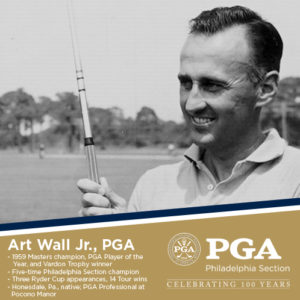
Art Wall, Jr. was born in Honesdale, Pennsylvania in 1923 and learned to play golf at the Honesdale Golf Club. Wall got his start in golf by caddying for his father at Honesdale. After high school he entered the service and served during World War II. When the war ended Wall enrolled at Duke University where he played on the golf team and roomed with Mike Souchak, graduating in 1949, at the age of 26. Wall won the Pennsylvania Amateur twice in the late 40s. After college he turned pro and worked as an assistant on Long Island for two summers, while testing his game on the PGA winter tour. In late 1951 he joined the PGA Tour full time and picked up his first win at the Ft. Wayne Open in 1953. The next year Wall won the Tournament of Champions and he went on to win twelve more PGA Tour events. Along with his victories on the PGA Tour, Wall won ten times on the Caribbean Tour. His last win came at the 1975 Milwaukee Open at the age of 51, which made him the second oldest to win on the PGA Tour. His best year was 1959 when he won the Masters Tournament along with three other tournaments. That year he was the PGA “Player of the Year”, won the Vardon Trophy for the lowest scoring average, led the PGA Tour in money winnings and earned a spot on the Ryder Cup team. The next year Wall won the Canadian Open. He played on three Ryder Cup teams and served on the PGA Tour’s four-man Policy Board three years. He tied for second at the 1974 Senior PGA Championship in his first year of eligibility and went on to several more high finishes in the tournament. In 1978 he won the U.S. National Senior Open by four-strokes with a 72-hole score of 18-under par. That National Senior Open was two years before there was a PGA Senior Tour or a USGA Senior Open. Some credit for the creation of the PGA Senior Tour should go to Wall. In April 1979 he was teamed up with Tommy Bolt at the Legends of Golf Tournament in Texas. At the end of regulation play they were tied with Julius Boros and Roberto De Vicenzo. In the sudden death playoff four holes were halved with birdies before the Boros-De Vicenzo team won with a birdie on the sixth extra hole. NBC-TV stayed with the telecast, which knocked out their Sports World and Nightly News shows. The TV ratings were so good that the PGA Tour decided that a PGA Senior Tour could be of interest to the golfing public. During his career Wall made so many hole-in-ones that it reached the point where he refused to divulge the total. For most of his career he represented the Pocono Manor Resort where his son Greg was later the professional for many years. He played in 31 Masters Tournaments, 15 U.S. Opens and 12 PGA Championships. Wall won the Philadelphia Section PGA Championship five times.
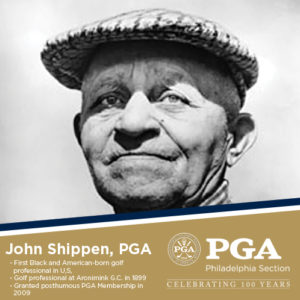 John Shippen: John Matthew Shippen, Jr. was born in Washington D.C. on December 2, 1879. His father John Sr., was born into slavery in Virginia. When the Civil War ended he was a free man. He moved to D.C. and attended Howard University. Upon graduation he became an Episcopalian minister. In 1888 the church sent John Sr., his African American wife and children to the far end of Long Island to bring Christianity to the Shinnecock Indians.
John Shippen: John Matthew Shippen, Jr. was born in Washington D.C. on December 2, 1879. His father John Sr., was born into slavery in Virginia. When the Civil War ended he was a free man. He moved to D.C. and attended Howard University. Upon graduation he became an Episcopalian minister. In 1888 the church sent John Sr., his African American wife and children to the far end of Long Island to bring Christianity to the Shinnecock Indians.
The Shinnecock Hills Golf Club opened in 1891 and the golfers needed caddies. John and his brother Cyrus along with some of the Indian boys became caddies and some learned to play the game.
By 1896, with the US Open scheduled for Shinnecock Hills, 16 year old John Shippen was being proclaimed in newspapers around the USA. It was written that he was a long straight driver and could play all the shots. He was the holder of the Shinnecock Hills course record, having lowered the number set by then Shinnecock professional Willie Dunn, by six strokes. Dunn had given Shippen pointers on how to play the game.
When the 1896 US Open rolled around in July, Shippen was paired with Charles Blair MacDonald, 1895 US Amateur champion. Oscar Bunn, one of the Shinnecock Indian caddies was also entered. Some of the Shinnecock members paid their entry fees. When the British born professionals learned there was a black golfer entered they produced a signed petition, refusing to play. USGA President Theodore Havemeyer stated that there would be a tournament even if only Shippen and Bunn were in the field. The protesting players decided to play.
The tournament, one day of 36 holes, was won by James Foulis, a Scotland-born professional from Chicago with rounds of 78 and 74 for 152. Despite poor putting, Shippen posted a 78 in his morning round. In the afternoon he took 11 strokes on the 13th hole when his tee shot ended up on a sandy road, where it took several strokes for him to escape. He finished with an 81 for 159 and a tie for sixth and last money. Some years later he said the hole was an easy par four, but his drive was a little too far to the right.
After working as the professional at Maidstone Golf Club, Shippen became the professional at Aronimink Golf Club in 1899, for that one year. His brother Cyrus was his assistant. At times his employers, to justify his employment, would say that he was not a black man but of English/Indian decent. It was said and written that Shippen was related to John Raife on his father’s side and Pocahontas on his mother’s side, which was far from realty. Shippen himself had registered for that 1896 US Open as a Shinnecock Indian, to avoid problems. In later years in an interview with his daughter, she said her father was 100 percent black.
As the professional at Aronimink, Shippen finished third in a driving contest at the 1899 US Open. He played in six US Opens, tying for 5th in 1902 along with his tie for 6th in 1896.
For many years Shippen was the professional and course supervisor at the Shady Rest Golf & Country Club in Scotch Plains, New Jersey. It was later Scotch Hills Country Club. In 1991 the John Shippen Foundation was created to offer golf instruction and competition for young minority golfers.
In 2009, the PGA of America bestowed Shippen with posthumous membership. Thurman Simmons and Shippen’s late grandson, Hanno Smith, attended the ceremony at the PGA Annual Meeting in New Orleans.
Learn more about John Shippen via PGA.com: pga.com/story/pga-professional-john-shippen-and-the-preservation-of-a-pioneering-legacy
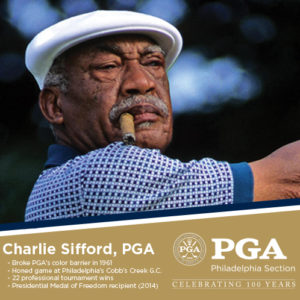 Charlie Sifford: Charlie Sifford was the first person of color to compete in PGA-sanctioned events following the demise in 1961 of the “Caucasian-only” PGA of America membership clause.
Charlie Sifford: Charlie Sifford was the first person of color to compete in PGA-sanctioned events following the demise in 1961 of the “Caucasian-only” PGA of America membership clause.
Sifford honed his game here in the Philadelphia PGA Section, at the municipal Cobb’s Creek Golf Course, a facility which allowed golfers from all backgrounds to play and enjoy the game. As our Section Historian Pete Trenham put it, “Without Cobb’s Creek, we probably never would have heard of Charlie Sifford.”
Even in the face of adversity, Sifford had a successful career, winning 22 times professionally, including two PGA Tour wins: the ’67 Greater Hartford Open and the ’69 Los Angeles Open.
Sifford won the 1975 @ his only major championship, at Walt Disney World in Florida.
He was inducted into the World Golf Hall of Fame in 2004, and President Obama awarded Sifford the Presidential Medal of Freedom in 2014.
Sifford’s hard work and determination, struggles and successes helped pave the way for many more people of color to enjoy the game and compete professionally. He is truly one of the greats of our game.
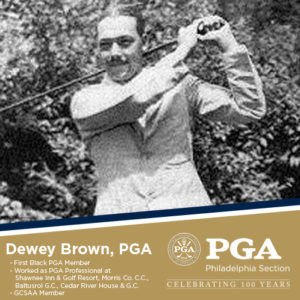 Dewey Brown: Before Charlie Sifford, before Pete Brown and before Lee Elder there was a PGA member of African descent named Dewey Brown.
Dewey Brown: Before Charlie Sifford, before Pete Brown and before Lee Elder there was a PGA member of African descent named Dewey Brown.
Dewey Brown was born in North Carolina in 1898 and grew up in New Jersey. He was introduced to golf as a caddy at the Madison Golf Club. Before long he was working on the golf course mowing fairways behind a horse drawn mower for $1 a day.
By the age of 18 he was an accomplished golfer and had become interested in club making. He began working under the golf professional at the Morris County Country Club as a club maker. He must have learned quickly as he made a set of clubs for Chick Evans that Evans used to win the 1916 U.S. Amateur at Merion Golf Club. Brown later made a set of clubs for United States President Warren G. Harding.
In 1918 Shawnee Inn & Country Club professional Willie Norton hired Brown as his assistant. At Shawnee Brown gave many golf lessons. During the winter months he would return to New Jersey and work for Baltusrol Golf Club professional George Low teaching indoors and making golf clubs.
At one point Brown left Shawnee to buy a farm but he returned in 1925 and stayed on for another 12 years. In 1928 he became a member of the PGA of America but in 1934 the PGA inserted a clause in its by-laws stating that the members had to be Caucasians. His membership in the PGA was terminated.
He left Shawnee in 1937 to manage clubs in New Jersey and New York, but in 1946 he returned to Shawnee one more time. Fred Waring, the famous bandleader, had bought Shawnee and hired Brown to be his hotel manager. He did not stay long as a new opportunity beckoned. He bought the Cedar River House & Golf Club in Indian Lake, New York. By then he was certainly qualified to own an inn and golf club. Brown managed the hotel and was the golf professional as well. Eleven years after buying the Cedar River House he joined the Golf Course Superintendents Association of America.
When the PGA eliminated the “Caucasian Only” clause from its by-laws in 1962 Brown applied for reinstatement. A couple of years later he was a “Class A” PGA member again.
When Dewey Brown retired in 1972 one of his son’s took over the business. Brown died in 1973 and is buried in Indian Lake Cemetery which is across the road from his Cedar River Golf Club. Some golf historians have referred to him as one of America’s golf pioneers.
Learn more about Dewey Brown from this July 2017 PGA Magazine article by clicking here.
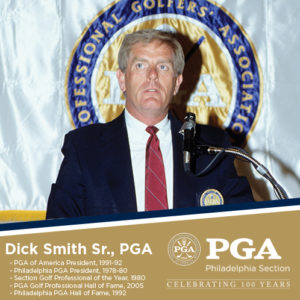 Dick Smith Sr.: Dick Smith was born in Ohio in 1942 and grew up in Baltimore, Maryland. At age ten he began playing golf with his father at the Mount Pleasant Golf Course, a public course where he also caddied. He got his start playing competitively in the Baltimore City’s junior golf program. Each Monday morning in the summer the junior golfers could get on a bus at the Baltimore Country Club’s city course and be driven to a golf course where there would be a junior tournament for them to take part in. In 1959 he won the Maryland State Jaycee Junior Championship. Smith attended Loyola College in Baltimore and turned pro in 1962. That year he came to the Philadelphia Section as an assistant to George Griffin, Jr. at the Green Valley Country Club. In 1963 Smith joined Ken Gibson in New Jersey where he helped run the Golf Farm, the Indian Spring Golf Course and the Wedgwood Country Club. Smith credited Gibson with giving him the most help with his golf game. In the early 1970s he was the pro-manager of the Hi-Point Golf Club and in 1975 he went back to Wedgwood in a partnership that leased the course. One of the partners was Dick Hendrickson who he had caddied for when he was growing up in Baltimore. Smith moved over to the Woodcrest Country Club in 1981 as the head professional where he stayed for twelve years. Other than the pros that were successful on the PGA Tour, Smith had the most outstanding record in the Section’s tournaments. Smith won three Section Championships in succession and he won the tournament a total of five times. This tied him with Art Wall for the most wins in the Section Championship. Smith played in five PGA Championships and a U.S. Open. He qualified for the PGA Club Professional Championships fifteen times and the PGA Senior Club Professional Championship three times. In 1970 he tied for fourth at the Club Professional Championship and he won the Philadelphia Open. Beginning in 1969 there were seventeen Section Challenge Cup teams that competed against the Middle Atlantic Section and Smith was a member of the team sixteen times. Twice in the early 1970s Smith won the four round Prior Festival, which was the Section’s richest tournament at that time. Smith tied for 18th in the 1971 PGA Tour’s IVB Golf Classic, which was held at the Whitemarsh Valley Country Club and in 1978 he tied for 17th at the IVB. He played in two U.S. Senior Opens and two PGA Seniors’ Championships. In the Philadelphia Section Smith was the Section’s “Player of the Year” five times and he won the DeBaufre Trophy for leading the Section in scoring average six times. After several years of serving on the tournament committee Smith was elected to the office of first vice president at the 1974 fall meeting, which made him the tournament chairman as well. This was his first political step in what would take him to the highest office in the PGA of America. After three years as the Section’s first vice president Smith was elected president. He served the Section as its 22nd president for three years, 1978 to 1980. In late 1983 the Philadelphia Section sent Smith to the national PGA for a three-year term as its director representing District II. At the national meeting in 1986 Smith was elected to national office for a two-year term as secretary. After that he served as the vice president in 1989-1990 and president for 1991-1992. After leaving national office he also left Woodcrest to be the director of golf at the new Galloway National Golf Club, which was still under construction. Two years later he purchased the Williamstown Golf Center, which he operated for seven years. During that time Smith set up a partnership that leased the Bethpage State Park Golf Course’s golf shop from the state of New York for five years. That included 2002 when the U.S. Open was played at Bethpage. With the exception of the week of the U.S. Open, the lease gave them the opportunity to sell U.S. Open merchandise for those five years. During his time on Long Island he was a member of the Metropolitan Section and the Philadelphia Section. Smith returned to the Philadelphia Section full time as the director of golf at two new golf courses in South Jersey that were owned by a land development group. Smith and the Philadelphia Section created the Dick Smith Cup Matches that were contested each year between the assistants from the Central Counties Chapter and the assistants from the rest of the Philadelphia Section. In 2005 he was hired as the general manager at the Woodcrest Country Club where his son Dick Jr. had succeeded him as the golf professional and was now in his thirteenth year. Smith was the Philadelphia Section’s “Professional of the Year” in 1980 and he was an original inductee into the Philadelphia Section’s Hall of Fame in 1992. Smith was inducted into the PGA of America’s “PGA Golf Professional Hall of Fame” in 2005.
Dick Smith Sr.: Dick Smith was born in Ohio in 1942 and grew up in Baltimore, Maryland. At age ten he began playing golf with his father at the Mount Pleasant Golf Course, a public course where he also caddied. He got his start playing competitively in the Baltimore City’s junior golf program. Each Monday morning in the summer the junior golfers could get on a bus at the Baltimore Country Club’s city course and be driven to a golf course where there would be a junior tournament for them to take part in. In 1959 he won the Maryland State Jaycee Junior Championship. Smith attended Loyola College in Baltimore and turned pro in 1962. That year he came to the Philadelphia Section as an assistant to George Griffin, Jr. at the Green Valley Country Club. In 1963 Smith joined Ken Gibson in New Jersey where he helped run the Golf Farm, the Indian Spring Golf Course and the Wedgwood Country Club. Smith credited Gibson with giving him the most help with his golf game. In the early 1970s he was the pro-manager of the Hi-Point Golf Club and in 1975 he went back to Wedgwood in a partnership that leased the course. One of the partners was Dick Hendrickson who he had caddied for when he was growing up in Baltimore. Smith moved over to the Woodcrest Country Club in 1981 as the head professional where he stayed for twelve years. Other than the pros that were successful on the PGA Tour, Smith had the most outstanding record in the Section’s tournaments. Smith won three Section Championships in succession and he won the tournament a total of five times. This tied him with Art Wall for the most wins in the Section Championship. Smith played in five PGA Championships and a U.S. Open. He qualified for the PGA Club Professional Championships fifteen times and the PGA Senior Club Professional Championship three times. In 1970 he tied for fourth at the Club Professional Championship and he won the Philadelphia Open. Beginning in 1969 there were seventeen Section Challenge Cup teams that competed against the Middle Atlantic Section and Smith was a member of the team sixteen times. Twice in the early 1970s Smith won the four round Prior Festival, which was the Section’s richest tournament at that time. Smith tied for 18th in the 1971 PGA Tour’s IVB Golf Classic, which was held at the Whitemarsh Valley Country Club and in 1978 he tied for 17th at the IVB. He played in two U.S. Senior Opens and two PGA Seniors’ Championships. In the Philadelphia Section Smith was the Section’s “Player of the Year” five times and he won the DeBaufre Trophy for leading the Section in scoring average six times. After several years of serving on the tournament committee Smith was elected to the office of first vice president at the 1974 fall meeting, which made him the tournament chairman as well. This was his first political step in what would take him to the highest office in the PGA of America. After three years as the Section’s first vice president Smith was elected president. He served the Section as its 22nd president for three years, 1978 to 1980. In late 1983 the Philadelphia Section sent Smith to the national PGA for a three-year term as its director representing District II. At the national meeting in 1986 Smith was elected to national office for a two-year term as secretary. After that he served as the vice president in 1989-1990 and president for 1991-1992. After leaving national office he also left Woodcrest to be the director of golf at the new Galloway National Golf Club, which was still under construction. Two years later he purchased the Williamstown Golf Center, which he operated for seven years. During that time Smith set up a partnership that leased the Bethpage State Park Golf Course’s golf shop from the state of New York for five years. That included 2002 when the U.S. Open was played at Bethpage. With the exception of the week of the U.S. Open, the lease gave them the opportunity to sell U.S. Open merchandise for those five years. During his time on Long Island he was a member of the Metropolitan Section and the Philadelphia Section. Smith returned to the Philadelphia Section full time as the director of golf at two new golf courses in South Jersey that were owned by a land development group. Smith and the Philadelphia Section created the Dick Smith Cup Matches that were contested each year between the assistants from the Central Counties Chapter and the assistants from the rest of the Philadelphia Section. In 2005 he was hired as the general manager at the Woodcrest Country Club where his son Dick Jr. had succeeded him as the golf professional and was now in his thirteenth year. Smith was the Philadelphia Section’s “Professional of the Year” in 1980 and he was an original inductee into the Philadelphia Section’s Hall of Fame in 1992. Smith was inducted into the PGA of America’s “PGA Golf Professional Hall of Fame” in 2005.
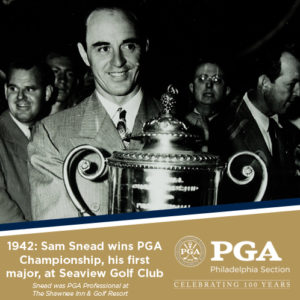 1942 PGA Championship: In the last week of May Seaview Country Club and its head professional Bruce Coltart hosted the PGA Championship. Seaview had two very dissimilar nines in architecture. There was the Bay Course with 18-holes designed by Donald Ross and 9-holes in the pines designed by Bill Flynn. It was decided that the back nine of the Bay Course would be played first and then the pros would finish on the Pines nine. In the later rounds the Bay nine was played last to accommodate the gallery. In the previous PGA Championships all the players received mileage money, which was based on how far they lived from the tournament site. In 1942 only those who failed to qualify for the match play were paid the mileage money. Hershey CC professional Ben Hogan, who hit more practice balls than anyone, hurt his wrist practicing the day before the championship started and had to have x-rays taken. Fred Corcoran, the PGA Tournament Manager, told the press that Hogan’s starting time for the next day would be pushed back a few hours from his scheduled time. Because the country was now at war, the pros were qualifying for only 32 places in order to shorten the championship by one day. All the matches were scheduled for 36 holes. PGA of America president Ed Dudley led the 100 starters on the first day of qualifying with a six-under-par 66, which tied the record for the lowest qualifying round in the PGA championship. At the end of qualifying Harry Cooper was the medalist with a 138, while Sam Byrd tied for second at 139. Dudley and Hogan were part of a three-way tie for fifth at 141. Coltart (142), Jug McSpaden (143), Jimmy Thompson (143), Dutch Harrison (144), Sam Snead (144) and Joe Kirkwood, Sr. (147) were the other members of the Philadelphia Section who made it into the match play. Kirkwood had to survive a playoff to win one of the last spots. Corporal Elwood Brey, Corporal Ed Oliver, Felix Serafin, Clarence Ehresman and Leo Diegel failed to qualify. Byrd, Coltart, Thomson and Harrison lost in the first round. In the second round Kirkwood lost to Byron Nelson and McSpaden lost to Jim Turnesa. Three Section members; Snead, Dudley and Hogan made it into the quarter-finals. Hogan then lost to Turnesa one-down and Dudley lost to Snead, who was the Shawnee Inn & CC playing professional, one-down. Dudley lost to Snead when his tee shot on the last hole hit a spectator and bounced into the woods for an unplayable lie. Snead beat Jimmy Demaret 3&2 in one semifinal match and Turnesa defeated Byron Nelson in a match that went 37 holes. Snead went on to defeat Turnesa, who was stationed at Ft. Dix, New Jersey, in the 36-hole finals 2&1. Snead took his first prize of $2,000 in a war bond, which would have been worth $1,500 in cash. The total purse was $7,550. Turnesa was granted leave to compete in the championship with the understanding that any money he won would go to the Army Relief Fund. Turnesa won $750 in cash and wore his army uniform while playing in the tournament. The total purse was $7,550. Two days later Snead was in the U.S. Navy as Seaman First Class Snead. The draft board had given Snead a 10-day extension on his reporting date so he could play in the PGA. Snead’s caddy was a young man named Tony DeSimone who went on to own an automobile dealership and a golf course in South Jersey. DeSimone became one of the Philadelphia Section’s most faithful sponsors. All profits from the tournament were donated to the Army and Navy relief funds. This was the last major golf championship played until the end of the war.
1942 PGA Championship: In the last week of May Seaview Country Club and its head professional Bruce Coltart hosted the PGA Championship. Seaview had two very dissimilar nines in architecture. There was the Bay Course with 18-holes designed by Donald Ross and 9-holes in the pines designed by Bill Flynn. It was decided that the back nine of the Bay Course would be played first and then the pros would finish on the Pines nine. In the later rounds the Bay nine was played last to accommodate the gallery. In the previous PGA Championships all the players received mileage money, which was based on how far they lived from the tournament site. In 1942 only those who failed to qualify for the match play were paid the mileage money. Hershey CC professional Ben Hogan, who hit more practice balls than anyone, hurt his wrist practicing the day before the championship started and had to have x-rays taken. Fred Corcoran, the PGA Tournament Manager, told the press that Hogan’s starting time for the next day would be pushed back a few hours from his scheduled time. Because the country was now at war, the pros were qualifying for only 32 places in order to shorten the championship by one day. All the matches were scheduled for 36 holes. PGA of America president Ed Dudley led the 100 starters on the first day of qualifying with a six-under-par 66, which tied the record for the lowest qualifying round in the PGA championship. At the end of qualifying Harry Cooper was the medalist with a 138, while Sam Byrd tied for second at 139. Dudley and Hogan were part of a three-way tie for fifth at 141. Coltart (142), Jug McSpaden (143), Jimmy Thompson (143), Dutch Harrison (144), Sam Snead (144) and Joe Kirkwood, Sr. (147) were the other members of the Philadelphia Section who made it into the match play. Kirkwood had to survive a playoff to win one of the last spots. Corporal Elwood Brey, Corporal Ed Oliver, Felix Serafin, Clarence Ehresman and Leo Diegel failed to qualify. Byrd, Coltart, Thomson and Harrison lost in the first round. In the second round Kirkwood lost to Byron Nelson and McSpaden lost to Jim Turnesa. Three Section members; Snead, Dudley and Hogan made it into the quarter-finals. Hogan then lost to Turnesa one-down and Dudley lost to Snead, who was the Shawnee Inn & CC playing professional, one-down. Dudley lost to Snead when his tee shot on the last hole hit a spectator and bounced into the woods for an unplayable lie. Snead beat Jimmy Demaret 3&2 in one semifinal match and Turnesa defeated Byron Nelson in a match that went 37 holes. Snead went on to defeat Turnesa, who was stationed at Ft. Dix, New Jersey, in the 36-hole finals 2&1. Snead took his first prize of $2,000 in a war bond, which would have been worth $1,500 in cash. The total purse was $7,550. Turnesa was granted leave to compete in the championship with the understanding that any money he won would go to the Army Relief Fund. Turnesa won $750 in cash and wore his army uniform while playing in the tournament. The total purse was $7,550. Two days later Snead was in the U.S. Navy as Seaman First Class Snead. The draft board had given Snead a 10-day extension on his reporting date so he could play in the PGA. Snead’s caddy was a young man named Tony DeSimone who went on to own an automobile dealership and a golf course in South Jersey. DeSimone became one of the Philadelphia Section’s most faithful sponsors. All profits from the tournament were donated to the Army and Navy relief funds. This was the last major golf championship played until the end of the war.
The PGA Championship final was played on Sunday May 31. That evening the PGA of America held a meeting of its executive committee. The Atlantic City Golf Association and Seaview Country Club had issued an invitation for the PGA to hold its championship at Seaview again in 1943. Due to the war the PGA wasn’t sure when it might hold its championship again. The PGA executive committee did vote to hold its championship at Seaview again and publicly stated that when it was played again it would be held at Seaview. There would be no PGA Championship held in 1943 and by 1944 when it was held the commitment to Seaview had apparently been forgotten.
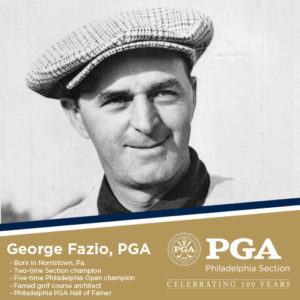 George Jerome Fazio: George Fazio was born in Norristown, Pennsylvania in 1912. He had a varied and outstanding career in golf. He worked as a golf professional, leased courses and driving ranges, won golf tournaments and designed golf courses. His career in golf began as a caddy at the Plymouth Country Club. He worked as a professional at six different golf courses in the Philadelphia area including the Pine Valley Golf Club in New Jersey and he played the PGA Tour on and off during the late 1940s and most of the 1950s. For a number of years Fazio owned a Ford automobile agency in Conshohocken that was set up for him by William Clay Ford. Locally Fazio won the Philadelphia Section Championship in 1941 and from 1949 to 1959 he won five Philadelphia Opens along with finishing second twice. In 1950 while working in the Middle Atlantic Section Fazio won their Section championship. He won twice on the PGA Tour, which included winning the Canadian Open in 1946, and finished second seven times. In 1950 he tied with Ben Hogan and Lloyd Mangrum for the U.S. Open title at Merion Golf Club and lost in an 18-hole playoff. He also finished fifth in the 1952 U.S. Open and tied for fourth in 1953. During his career he played in 14 U.S. Opens, 14 PGA Championships and 7 Masters Tournaments. Fazio also knew golf talent. When Gary Player first ventured to America to try his hand on the PGA Tour he wasn’t very successful. Fazio gave Player some money, which allowed him to stay on the tour. At the time Fazio was leasing Flourtown Golf Club and Langhorne Country Club so to return the favor Player agreed to represent Langhorne on the PGA Tour. In the mid 1950s television was in its infancy and a young Jack Whitaker was doing ten minutes of sports at 11:00 pm on WCAU TV. Whitaker could see that golf was becoming very popular so he invited Fazio to be a guest on his show each Wednesday evening. The Wednesday show with Fazio was a hit as hundreds of viewers sent in postcards and letters with golf questions. Some of the shows featured Fazio demonstrating various golf shots at the Presidential Course, which was what remained of the Philadelphia Country Club’s original course. In 1955 the city of Philadelphia hired Fazio to make changes that would tighten up its Cobbs Creek Golf Club for the PGA Tour’s Daily News Open that the course was hosting that year. That got him started in course design and in 1960 he shifted his career over to building golf courses. Fazio gained more fame as a golf course architect than he had from playing tournaments. He designed 64 courses and redesigned 20 more. Nine of the courses he created were in the Philadelphia Section. Several of his courses quickly made Golf Digest’s list of “America’s 100 Greatest Golf Courses. A number of golf courses that Fazio designed and golf courses that he redesigned hosted national championships and PGA Tour events. The list included the 1972 Masters, six U.S. Open courses and the 1968 U.S. Women’s Open. Fazio was inducted into the Philadelphia Section PGA Hall of Fame in 2008. For more of Trenham Golf History’s Leaders & Legends, visit https://trenhamgolfhistory.org/philadelphia-pga-leaders-legends/leaders-legends-1950-1959/
George Jerome Fazio: George Fazio was born in Norristown, Pennsylvania in 1912. He had a varied and outstanding career in golf. He worked as a golf professional, leased courses and driving ranges, won golf tournaments and designed golf courses. His career in golf began as a caddy at the Plymouth Country Club. He worked as a professional at six different golf courses in the Philadelphia area including the Pine Valley Golf Club in New Jersey and he played the PGA Tour on and off during the late 1940s and most of the 1950s. For a number of years Fazio owned a Ford automobile agency in Conshohocken that was set up for him by William Clay Ford. Locally Fazio won the Philadelphia Section Championship in 1941 and from 1949 to 1959 he won five Philadelphia Opens along with finishing second twice. In 1950 while working in the Middle Atlantic Section Fazio won their Section championship. He won twice on the PGA Tour, which included winning the Canadian Open in 1946, and finished second seven times. In 1950 he tied with Ben Hogan and Lloyd Mangrum for the U.S. Open title at Merion Golf Club and lost in an 18-hole playoff. He also finished fifth in the 1952 U.S. Open and tied for fourth in 1953. During his career he played in 14 U.S. Opens, 14 PGA Championships and 7 Masters Tournaments. Fazio also knew golf talent. When Gary Player first ventured to America to try his hand on the PGA Tour he wasn’t very successful. Fazio gave Player some money, which allowed him to stay on the tour. At the time Fazio was leasing Flourtown Golf Club and Langhorne Country Club so to return the favor Player agreed to represent Langhorne on the PGA Tour. In the mid 1950s television was in its infancy and a young Jack Whitaker was doing ten minutes of sports at 11:00 pm on WCAU TV. Whitaker could see that golf was becoming very popular so he invited Fazio to be a guest on his show each Wednesday evening. The Wednesday show with Fazio was a hit as hundreds of viewers sent in postcards and letters with golf questions. Some of the shows featured Fazio demonstrating various golf shots at the Presidential Course, which was what remained of the Philadelphia Country Club’s original course. In 1955 the city of Philadelphia hired Fazio to make changes that would tighten up its Cobbs Creek Golf Club for the PGA Tour’s Daily News Open that the course was hosting that year. That got him started in course design and in 1960 he shifted his career over to building golf courses. Fazio gained more fame as a golf course architect than he had from playing tournaments. He designed 64 courses and redesigned 20 more. Nine of the courses he created were in the Philadelphia Section. Several of his courses quickly made Golf Digest’s list of “America’s 100 Greatest Golf Courses. A number of golf courses that Fazio designed and golf courses that he redesigned hosted national championships and PGA Tour events. The list included the 1972 Masters, six U.S. Open courses and the 1968 U.S. Women’s Open. Fazio was inducted into the Philadelphia Section PGA Hall of Fame in 2008. For more of Trenham Golf History’s Leaders & Legends, visit https://trenhamgolfhistory.org/philadelphia-pga-leaders-legends/leaders-legends-1950-1959/
